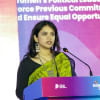Rape news should trigger more resistance

It's no secret that Bangladesh has long been plagued by violence against women and children. Bangladesh Mahila Parishad (BMP), an organisation working for the protection of women's rights, reported 592 incidents of rape that occurred across the country in the first six months of 2018. But what is more disturbing is how we are getting to hear more and more about incidents of rape of females of atypical age range—and how we are getting used to hearing them.
In 2017 alone, the number of headlines about girls as young as four years old being raped was disturbingly high. According to BMP, at least 2,063 women and children became victims of various types of violence, including rape, sexual harassment, physical torture for dowry, etc. Recently, an 80-year-old was raped by her neighbours, which shows the increasingly uncertain nature of the psychology behind rape.
Are we simply hearing more news because of the increased access to information, or are there additional factors that have contributed to the rise in sexual violence? True, social media has increased access to such news, but the number of rape incidents actually reported still remains low, at around 2 percent. Therefore, it stands to reason that rape, used as a tool to establish social dominance and control, is on the rise in new and twisted ways. New factors in this age of technology are contributing to an already prevalent rape culture and violent extremism while the legal system is failing to provide protection to the victims.
Let's look at how technology is contributing to the rising rape culture. The availability of smartphones and cheaper computers has led to an increased consumption of a wide range of pornography. According to Hola, a free VPN service that enables users to mask the location they are using their web browser from, the most visited website in Bangladesh is one of the world's largest pornographic video sharing websites.
Yes, pornography is viewed all over the world, but when graphic content is made widely available in a conservative, sexually repressive culture, it serves to increase the over-sexualisation of women. Most men here are still used to having women seated separately, or can only meet them playing hide-and-seek from society. And when they do get "access" to them in public spaces, including the cyberworld, their curiosity turns into a feudal psychosocial tendency to dominate over women—a class of people they have grown up hearing is inferior. A great example is the recent rape, mutilation and murder of a minority girl in Khagrachari, which reaffirms our belief that sexual homicide is intended to establish male dominance, and show women "their place".
Over the last few years, Bangladesh has made significant progress in improving gender parity and participation of women in the workforce. However, there is a noticeable correlation between women not getting protection and being engaged in spaces outside the domain of what is considered the "right place" for them. Thus, the hypocrisy of our patriarchal society protects men who stare lewdly or catcall at women in the streets, and tries to disregard women who speak out against such practices.
Violence against women—especially violence in private spaces—is not always seen as a crime but a private matter. The result is, domestic violence and marital rape remain the most underreported crimes. In the majority of Bangladeshi family units, even when a woman is a bread-earner, she is rarely the decision-maker or considered equal to the male members of the family.
As long as the climate in which rapists are confident of "getting away with it" exists, the vicious cycle of perpetration will not cease to exist. Bangladesh also has no specific laws related to femicide (Whose City, ActionAid, 2017). The appropriate authorities that are meant to prevent such incidents from taking place often fail to do so, thanks to a culture of corruption, misogyny and negligence of the police authorities, as well as an inbuilt tendency to assume that the fault is probably the victim's—not the perpetrator's. Most often cases are not accepted, and conviction rate is even lower. Aside from outside court settlements, police often don't want to report rapes to improve their crime-prevention statistics. Women in Bangladesh still feel unsafe and are concerned about the implications of reporting, as evidenced by the reluctance among women to go to the police to report a crime: 65 percent of women surveyed felt the police would rather blame them than the perpetrator, and 57 percent felt that the crime would not be taken seriously.
If we can bring positive shifts in early childhood education both in schools and at homes of both girls and boys, then prevention of violence will be possible. Boys should be taught that being strong doesn't mean hurting or disrespecting women/girls—it's the opposite of strength. But we should remain alert so that such messages do not get drowned out by the culture of misogyny that they might be exposed to as they grow up into adults.
Dibarah Mahboob is an author and artist.

 For all latest news, follow The Daily Star's Google News channel.
For all latest news, follow The Daily Star's Google News channel. 



Comments